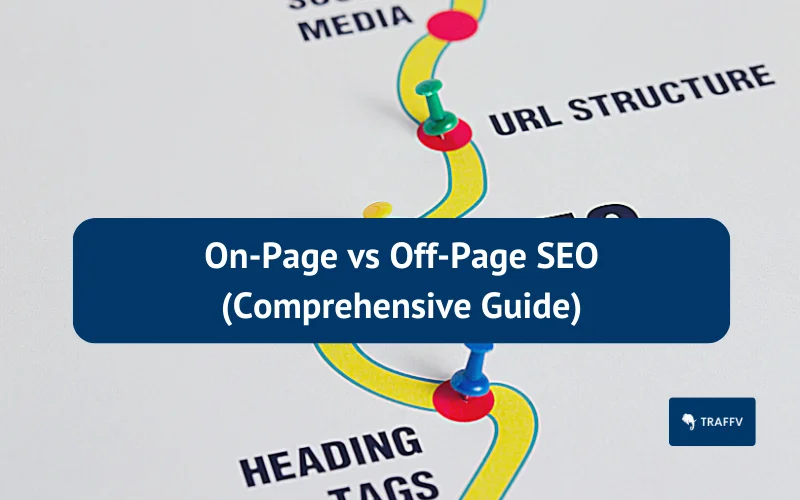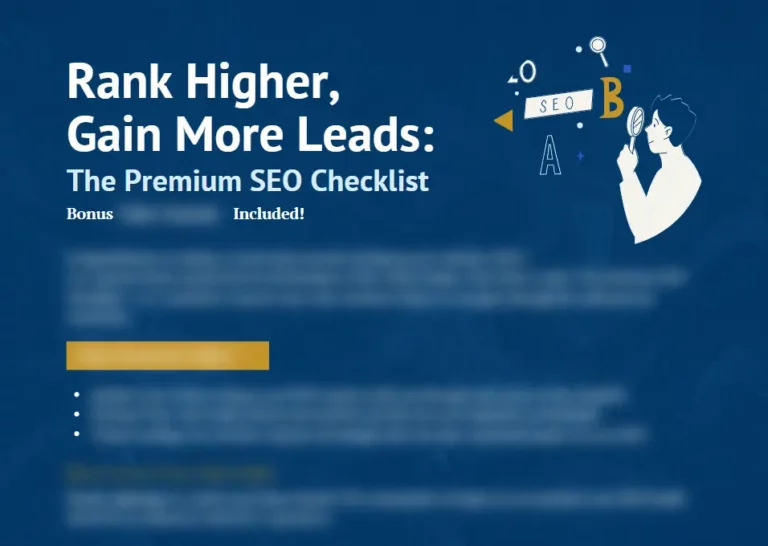In the realm of digital marketing, there’s no escaping the gravitational pull of SEO — Search Engine Optimization.
At the heart of a website’s visibility, SEO is no longer just a marketing buzzword; it’s a necessity.
It’s the secret ingredient that makes your website appealing to the algorithms of search engines.
But did you know there are two sides to this SEO coin?
Yes, SEO is a two-pronged approach comprising on-page SEO and off-page SEO, each with its unique factors and strategies.
As you navigate through this guide, you will understand the nuances of these strategies, how they work, and how they can be harnessed to improve your website’s performance and rankings.
So buckle up and let’s embark on this enlightening journey of understanding on-page vs off-page SEO.
TL:DR
- On-Page SEO focuses on elements within a website, while Off-Page SEO refers to external ranking factors.
- On and off page optimization are essential components of an effective SEO strategy.
What Is On-Page SEO?
When you hear “on-page SEO,” think of it as the heart of your website’s SEO strategy.
It refers to the optimization of elements that are within your control on your website.
It’s all about enhancing the visibility and readability of your web pages for both the search engines and the users.
This is achieved by optimizing a variety of on-page elements such as title tags, meta descriptions, content, and website performance.
On-page SEO, or on page optimization, is akin to dressing up your website for a grand ball. You want to look your best, right?
Similarly, on-page SEO ensures that your web page looks its best to the search engines.
The better optimized your website elements are, the better your website’s chances of waltzing up to the top of the search engine rankings.
The focus areas of on-page SEO extend to ensuring mobile-friendliness and optimizing for Core Web Vitals, which directly impact your website’s performance and user experience.
On-Page SEO Factors
Just like a well-oiled machine, on-page SEO comprises several components working in tandem to enhance your website’s visibility on search engines.
The gears that drive this machine are content quality, keyword optimization, and image optimization.
Each of these gears plays a vital role in the overall functioning of your on-page SEO machine, and we’ll dive deeper into each of these components in the following subsections.
Content quality is the cornerstone of any successful SEO strategy.
It involves creating SEO content that is both informative and informative.
Crafting High-Quality Content
In the world of SEO, content is king.
It’s the lifeblood that keeps your website alive and kicking in the digital space. High-quality content is the cornerstone of on-page SEO.
It’s not just about filling up your web pages with words.
It’s about creating content that is precise, relevant, and captivating. Think of it as a lighthouse; your content should serve as a beacon, guiding search engines and users to your website.
But what makes your content high-quality?
It’s the perfect blend of relevancy, accuracy, and engagement.
It’s about creating content that resonates with your audience, answers their questions, and engages them.
Moreover, it’s also about strategically placing Calls to Action (CTAs) to inspire your readers to take the desired action.
High-quality content is like a fine wine; it leaves the user wanting for more, thereby enhancing your website’s visibility and search engine rankings.
Keyword Optimization
While high-quality content forms the backbone of on-page SEO, search engine optimization is the nervous system that sends signals to the search engines about your website’s relevancy in search results.
Keyword optimization involves strategically utilizing target keywords throughout your website to enhance its visibility on search engines.
Imagine keywords as the DNA of your content.
They help search engines understand what your content is about and how relevant it is to a user’s search query.
However, the key is to use long-tail keywords, which are detailed, specific keyword phrases.
These keywords should be placed in various areas of your website, including blog posts, About Us page description, and product details, without overdoing it to prevent keyword stuffing.
Image Optimization
A picture is worth a thousand words, but in the digital world, an optimized image is worth a thousand clicks.
Image optimization is a critical aspect of on-page SEO.
It’s about adjusting images on your website to enhance its performance, user experience, and SEO.
And it’s more than just uploading images to your website. It involves defining user-friendly file names, adding relevant alt tags, and making images mobile-friendly.
The benefits of image optimization are many.
It not only decreases page loading times and enhances accessibility, but also facilitates search engine bots to crawl and index images.
The key steps to optimize images include compressing file sizes, including descriptive alt tags, and ensuring mobile-friendliness.
Remember, an optimized image can be the difference between a user bouncing off your website and staying to explore more.
What Is Off-Page SEO?
Stepping outside the confines of your website, off-page SEO comes into play.
Think of off-page SEO as your website’s reputation manager.
It’s about what others say about you.
It involves increasing the authority of your domain by obtaining links from external websites.
The primary focus of off-page SEO is to ensure that your site, company, and brand is discussed on other websites, thereby increasing your visibility and credibility.
In the game of SEO, off-page SEO is the queen.
Just as the queen holds significant power in a game of chess, off-page SEO holds a considerable influence over your website’s ranking on SERPs.
The off-page SEO factors that make a substantial impact include backlinks, social media presence, and domain authority.
Backlinks are like votes of confidence from other websites.
The more backlinks your website has from reliable sources, the higher it ranks on SERPs.
Off-Page SEO Factors
Taking a deep dive into off-page SEO, we come across various factors that contribute to enhancing your website’s visibility and authority.
The key factors that steer the ship of off-page SEO include building quality backlinks, leveraging social media, and encouraging social proof.
Let’s now set sail and explore each of these factors in the following subsections to understand their significance in off-page SEO.
Building Quality Backlinks
In the realm of off-page SEO, link building is a crucial strategy.
Backlinks are your most trusted allies, like gold stars on your website’s report card, indicating its reliability and relevance to the search engines.
Quality backlinks enhance your website’s credibility and reputation, contributing to improved search engine rankings.
So, how can you build these golden stars for your website?
One approach is to compose guest posts for other reputable blogs related to your topic and link to your content.
Another effective strategy is to create content in popular formats like how-to guides, “best of” lists, and infographics that other websites will find worth linking to.
Remember, the anchor text should be pertinent to the content that is linked and suggestive of a pertinent keyword you’re targeting.
Leveraging Social Media
Social media is a powerful weapon in your off-page SEO arsenal.
It’s like a town hall where you can promote your content, connect with your audience, and foster relationships with other industry influencers.
Effectively leveraging social media platforms can help in building a brand and improving your website’s visibility.
Imagine social media as a bustling bazaar.
The more active you are, the more buyers (or in this case, visitors) you attract.
Posting regularly on social media sites helps to control the Search Engine Results Page (SERP).
Remember, the key is to engage with your audience, respond to their queries, and provide them with valuable content that they find worth sharing.
Encouraging Social Proof
Social proof is the cherry on top of your off-page SEO cake.
It’s a psychological phenomenon where people imitate the actions of others, believing that those actions are indicative of the right behavior.
In marketing, social proof is employed to demonstrate that other people have purchased and derived benefits from a product or service provided by a company.
Think of social proof as a word-of-mouth recommendation.
It’s about showing your potential customers that others trust your products or services.
To bolster social proof, you can feature customer reviews, testimonials, and case studies on your website.
Social media can also be utilized to showcase customer success stories and positive feedback.
On-Page vs Off-Page SEO: The Key Differences
While both on-page and off-page SEO contribute to improving your website’s visibility and search engine rankings, they are as different as chalk and cheese.
On-page SEO is about the various elements within your website that you can control, such as content, meta descriptions, and website performance.
On the other hand, off-page SEO refers to all the ranking factors outside your website, such as backlinks, social media presence, and domain authority.
Think of it as the difference between an individual’s character and reputation.
Character is what an individual is like when no one is watching, which is akin to on-page SEO – it’s about what you do on your website.
Reputation, on the other hand, is what others think of the individual, similar to off-page SEO – it’s about how other websites perceive your website.
The key to a successful SEO strategy is to prioritize both on-page and off-page SEO strategies.
Using On-Page and Off-Page SEO
On-page and off-page SEO are two very important aspects of SEO.
They are like two sides of a coin – each one is integral to achieving success in SEO.
Both are crucial for a successful SEO strategy.
Just as a coin needs both sides to hold value, your website needs both on-page and off-page SEO to enhance its search engine rankings and visibility.
Let’s now delve deeper into how you can prioritize on-page SEO and expand off-page SEO techniques to optimize your website.
Prioritizing On-Page SEO
On-page SEO is your first step towards a successful SEO strategy.
It’s about optimizing the content and structure of your website’s individual pages to enhance their search engine rankings.
Think of it as setting the foundation of your house; you need to get it right before you can build anything on top of it.
This includes adjusting a page’s content, tags, and internal links to improve search visibility.
Imagine being an artist, and your website being your canvas.
You need to paint it with high-quality content, optimized keywords, and well-optimized images.
You also need to ensure your canvas (website) performs well by optimizing page loading speed and user experience.
Once your canvas is ready, you can showcase it to the world, i.e., the search engines and users.
Expanding Off-Page SEO Techniques
Once you’ve set the foundation with on-page SEO, it’s time to build on it with off-page SEO.
Off-page SEO techniques can be expanded to enhance your website’s visibility and authority.
It’s about creating valuable backlinks, social media marketing, guest content, and more.
The goal is to enhance your website’s ranking on search engine results pages (SERPs) by increasing its popularity, relevance, trustworthiness, and authority.
Think of off-page SEO as the word-of-mouth marketing for your website.
The more people talk about your website, the more visibility and credibility it gains.
You can generate backlinks by producing content that other websites will link to.
You can also leverage social media to promote your content, connect with your audience, and foster relationships with other industry influencers.
And finally, you can encourage social proof by featuring customer reviews and testimonials on your website.
Achieving an SEO Balance
It’s evident that both on-page and off-page SEO play a crucial role in a successful SEO strategy.
The key to a successful SEO strategy lies in prioritizing both on-page and off-page SEO strategies.
While understanding and implementing on-page and off-page SEO strategies might seem like a daunting task, SEO services can help businesses navigate the complex world of SEO and effectively implement on-page and off-page SEO strategies for improved search engine rankings and visibility.
Frequently Asked Questions
Which is better on-page SEO or off-page SEO?
On-page SEO covers optimizing the content and structure of your website, while off-page SEO includes tactics such as building links and using social media marketing.
Both are important for effective SEO, and depending on your needs, you can sometimes focus more on one of those SEO types.
What is on-page and off-page in SEO?
On-page SEO involves optimizing a website for search engines by improving its content, titles, headings, URLs and internal links.
Off-page SEO refers to external signals, such as link building and content sharing from other websites, to help increase a website’s ranking and visibility.
What is the difference between technical on-page and off-page SEO?
Technical SEO focuses on non-content related elements, while On-Page SEO refers to optimizing content itself and Off-Page SEO focuses on external activities such as link building and online visibility.
What are the key factors of on-page SEO?
On-page SEO is essential for improving website visibility and search engine rankings, and it requires quality content, keyword optimization, and image optimization to be effective.
What is off-page SEO and how does it work?
Off-page SEO is the process of building links from external websites to increase the authority of your domain.
It works by creating visibility and credibility through discussion of your site, company, and brand on other websites.




